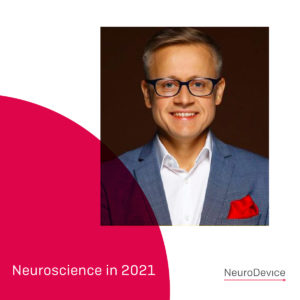What will 2021 in our industry be like?

After a pandemic year, it basically seems obvious that 2021 should only get better. But that is too general a statement to agree with. Moreover, Covid-19 still wins against us, not us against it, so any scenario is possible. I also believe that this year will continue to be marked by great uncertainty.
Looking beyond neurostimulation, the following months will rather direct our attention to the further fight against the virus and its complications (also in the field of neurology and psychiatry). While life slowed down, we began to notice aspects unnoticed before – our closest home environment, for which we began to care more, but also a general outlook on the world and what we – humans mean in this world. Fortunately, we have started to care more about nature, which already gives us a very good start for our and our children’s future. My impression is that we are also more sensitive to fake news in the media, which should result in greater confidence in science in the future. In 2021 year we will work more effectively, at least for two reasons: because we will have to make up for what we could not do due to lockdowns; because we’ve learned that we don’t always have to meet in person (wasting time getting to the meeting, sometimes to the other side of the globe) to achieve our business goals.
The year 2021 in neurostimulation, and more broadly in neurology, should be a very interesting one.
First, the impact of the pandemic on remote therapy approaches. We keep hearing about a telemedicine boom. Institutions regulating the market of medical devices drew attention to the possibility of its wider application in diagnostics and therapy – Neuroelectrics has received approval for remote research on the tDC stimulator for drug-resistant epilepsy in children; Miro Health has implemented an online tool for diagnosing neurological disorders, i.e. the doctor can perform an effective diagnosis of the patient without inviting him to the office. The pandemic has significantly accelerated the acceptance of the so-called digital health and remote healthcare.
Second, the pandemic’s impact on mental health. Loneliness or post-Covid complications, such as depression, anxiety, strokes, attention and concentration disorders, and aphasia will accelerate work on the diagnosis and therapy of diseases within the mental health spectrum. Already we can see examples of startups building on the remote psychiatric consultation and online psychotherapy service. This trend will be strengthened and expanded with speech, memory, attention and concentration therapy, spatial-visual functions, thinking etc. I feel that the very issue of treating this type of disorders at home, i.e. a familiar and safe environment for the patient, will be a huge breakthrough in the effectiveness of therapy, not to mention the frequency of therapy sessions. Exercises performed at home will have a higher frequency.
Third, if the number of lockdowns decreases (which we can count on given the growing number of vaccinated people), I expect more clinical trials, including those of neuroscientific solutions. Over the past year, many companies and research groups have had to curtail their research. Our company has suffered a significant slowdown in our two clinical projects, and the third could not even start due to hospital closures. Now it will have to be made up for. The second issue is the effect of the pandemic, which has shown that many of the research projects can be done more effectively in patients’ homes. Regulatory institutions have sought to facilitate the transformation of clinical research into a decentralized approach. This trend will probably stay with us. The end result will be the faster emergence of new diagnostic and therapeutic solutions on the market. Hopefully, our Voic System will be among them.
Fourth, the development of neurostimulation has finally gained momentum. There are more and more publications on current and magnetic stimulation therapy. Within these areas, new forms are also emerging, e.g. in current stimulation – tACS, in magnetic – rTMS, and within it QPS, or ultrasound stimulation. At scientific conferences, it is more common to discus how to choose the parameters of stimulation to be effective, not whether such solutions work at all.
Fifth, the FDA’s Breakthrough Devices Program will speed up the market approval of devices (largely neuro-devices) that provide more effective treatment or diagnosis of life-threatening diseases. This gives hope for faster adaptation of solutions in the field of neuroprosthetics and neurostimulation.
Sixth, the latest Neuralink and Kernel presentations have highlighted how technologically and conceptually we are poised to improve lives and, in many cases, save the lives of patients who until recently had no or less hope. The media power of Elon Musk and Bryan Johnson is helping neuroscience enter the mainstream, thus accelerating the pace of works in the field of neuroprosthetics.
Seventh, the pandemic has shown how important it is the medical advancement, and this has entailed and will continue to stimulate increased investment in research and development as well as digital health. It will accelerate the entry of giants such as Alphabet, Amazon, Apple, Microsoft or Walmart, but also smaller technology companies to medicine and neuro. Especially e-commerce companies will increase their investments, because after a year of online shopping, they have more funds than ever before. Some forecasts show that only in 2021, investments in healthcare and medtech will double compared to 2020.
As for the eighth point, I could describe the influence of AI on neurodiagnostics and therapy, but this is a topic for a whole separate post…